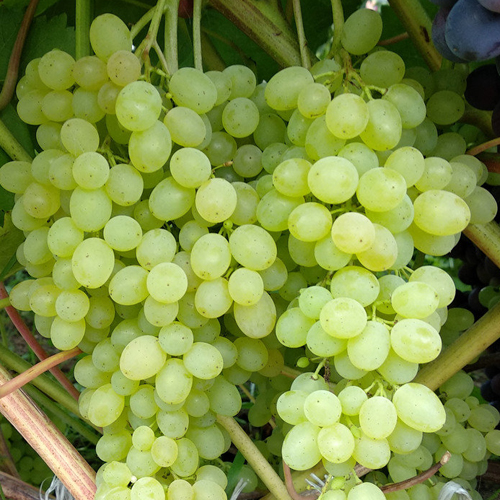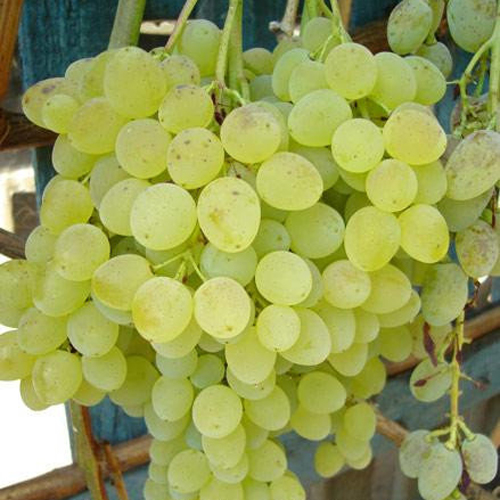Rusbol grape variety
The magnificent soft-seeded variety Rusbol is a joint development of domestic scientists from the All-Russian Research Institute of Viticulture and Winemaking named after V.I. ME AND. Potapenko and Bulgarian breeders from the Pleven Institute. Actually, the grape got its name thanks to this fruitful cooperation. However, in addition to this, the hybrid is also known under the name Kishmish Mirage.

It was obtained as a result of crossing a complex interspecific hybrid Villard Blanc (Save Villar 12−375) of French origin and the Superearly seedless variety, bred by the Crimean Research Institute "Magarach". The maternal form served as a donor of resistance genes for her descendant, and the paternal form became responsible for the high quality of the fruits, and primarily for the absence of full-fledged seeds in the berries, instead of which there are only underdeveloped rudiments. The direct authors who worked on the hybrid, from the Russian side, were I.A. Kostrikin, L.A. Maistrenko, A.S. Skripnikova, and with Bulgarian - Jordan Ivanov and Vasil Valchev.
The novelty aroused great interest among amateur winegrowers, who liked not only the gastronomic characteristics of the grapes, but also their unpretentiousness in care, which is a rarity for raisins. In addition, an important role in expanding the geography of Rusbol cultivation was played by its early ripening period and increased frost resistance, which made it possible to obtain a high-quality harvest not only in the traditional southern wine-growing regions, but also much further north.
Agrobiological characteristics
In the first years after planting, the bushes are characterized by medium vigor, but subsequently become vigorous. The crown of the young shoot is closed, greenish-red, without pubescence. Young leaves are wrinkled, shiny with a noticeable bronze tint. The shoot axis is green with numerous longitudinal red stripes. A typical grape leaf is large, rounded or stretched in width, usually consisting of five lobes, the dissection between which is practically absent. The surface of the leaf blade is rich green with light veins, reticulate wrinkled. The upper side cutouts are small, predominantly in the form of a recessed corner. The lower notches are usually absent. The petiolate notch is lancet. Petioles are bright red due to intense anthocyanin pigmentation, medium in length. The teeth along the perimeter of the leaf are large, triangular, with wide bases, smooth edges and sharp tops. The inflorescences are very large, the flowers are bisexual, and therefore their fertilization occurs without any problems. There were no drawbacks in the form of shedding of buds, ovaries, as well as peas of berries for the variety. Annual shoots of Rusbol ripen early and very well, after which they acquire a reddish-brown color.

The size of the ripe grapes is large and very large. Their average weight is 500-600 grams, many of them reach up to a kilogram, and some even up to one and a half kilograms. The shape of the brushes can be varied: cylindrical-conical, winged or branched. The density is medium. The combs are long, herbaceous, often lignified at the base, greenish-red in color. The berries are medium, weakly oval or ovoid, 18 mm long and 16 mm in diameter. Painted white, and the surface is covered with a light layer of a light waxy coating. The weight of 100 grapes is 300-400 grams. The consistency of the pulp is juicy and fleshy, the taste is simple, harmonious, the aroma does not carry bright varietal shades. Colorless juice squeezed from berries contains a large amount of sugars - 19-21 g / 100 ml, while the titratable acidity is 5-7 g / l. The skin of the grapes is thin, but at the same time quite strong, it can be chewed when eaten without any problems.The main distinguishing feature of our hero is the presence of soft, underdeveloped seeds in the berries, due to which he is classified as a variety with IV class of seedlessness. This increases to a certain extent the gastronomic value of the crop, which has a positive effect on those tasting ratings that are awarded to it. Fresh Rusbol is rated at 7.6 points, and dried - 7.8 points.
The directions of using the obtained crop can be very diverse. First of all, and in the largest volumes, grapes go directly to food. And although it is somewhat inferior in its attractiveness to the appearance of large-fruited table varieties, the actual absence of seeds makes it very popular among consumers. For this reason, it is also appreciated by farmers who grow grapes for sale. An additional advantage for them is its early maturity, which makes it possible to increase the profitability of crop cultivation due to higher prices on the market before the mass ripening of old traditional varieties begins. In terms of the transportability of the crop, Rusbol cannot be called suitable for long-distance transport, rather it is a variety for local consumption. It is also not adapted to long-term storage and without losing its presentation can only withstand short periods of time in refrigeration chambers. When processed, it shows itself very well in compotes, preserves and jams, and also as an excellent raw material for obtaining juice. These qualities are often used by those amateurs who grow it for themselves, because gigantic volumes of the harvest can not be consumed fresh. Drying is another potential processing option, but the resulting product is not always delightful due to the rather large rudiments of the seeds for raisins.

Indicators of early maturity are characterized by a short growing season, which is necessary for plants to ripen grapes. So, from the day of budding until the onset of the removable maturity of the bunches, it usually takes 115-120 days, and in the south the harvest becomes ready for harvest in the second decade of August. During this period, the accumulated sum of active temperatures does not exceed 2450-2550 ° C. This allows us to consider the variety as quite plastic and adapted for cultivation in regions unconventional for viticulture, where a relatively modest level of heat supply will be enough for full ripening of the crop. In particular, the latitude of such cities as Oryol, Tambov, Lipetsk can be considered the northern border of cultivation in open ground, and provided that measures are taken to increase SAT, then this is not the limit. The increased resistance of Rusbola vines to the winter cold (-25 ° C) makes it possible to form bushes in the southern regions on a high boom without shelter for the winter, and in frost-prone areas to be limited to light shelters.
The yield potential of our hero is truly limitless. In particular, the percentage of fruitful shoots reaches 85-90%, and the number of clusters per shoot is 1.5-1.9. It is not without reason that it is called “suicide” because the number of brushes to be laid is much greater than the possibilities that plants have in order to “stretch” this entire volume of harvest to the required conditions. For this reason, our hero needs a mandatory rationing of productivity and a conscious limitation by the grower of the exorbitant generosity that the bushes that have begun to bear fruit demonstrate. If this is not done, grapes from overloaded plants will sharply reduce their taste, bunches and berries are crushed, the growth of shoots will decrease and their ripening will worsen. Ultimately, weakened bushes risk even dying due to a decrease in the frost resistance of the vine.On the other hand, the excessive potential of Rusbol's productivity opens up broad prospects for a competent winegrower to increase the yield of the variety by improving the agricultural background, carrying out regular watering and feeding. Fully supplied with heat, moisture and mineral nutrition, the plants are ready to show phenomenal results.
Ripe bunches, weather permitting, can be left hanging on the bushes for several weeks. They are not damaged by wasps, which eliminates the need for time-consuming protection from annoying insects. But, at the same time, in rainy weather, the berries can crack, sharply reducing their presentation, as well as the already not very high storage and transportation capacity. This flaw must be taken into account already when the grapes are ripening, and measures must be taken to prevent a sharp change in soil moisture, whether it be watering the vineyard during dry periods, or at least mulching the soil under the bushes.
Agrotechnical features
According to its economic characteristics, Rusbol is close to unpretentious, complex-resistant varieties, and therefore its cultivation will not become unnecessarily difficult even for an inexperienced owner.
When planted, grapes are completely unpretentious to soil conditions, being able to grow on soil with different levels of fertility and moisture. Only unnecessarily damp wetlands and places with groundwater occurrence close to the surface will not suit him. With regard to the terrain, our hero is also undemanding, and here the only limitation will be the slopes of the northern exposures, as well as various lowlands and gullies, where stagnation of cold air is noted.
Rusbol can grow both on its own roots, which is facilitated by the good rooting of its cuttings, and on numerous well-known rootstock forms, with which it has excellent compatibility. The choice of the propagation method depends entirely on the presence of phylloxera root in the soil, which can cause irreparable harm to its own-rooted plantations.
The most successful option for keeping a bush of grapes is a non-covering high-standard cordon form, on which the variety is able to reveal its full potential. However, this scheme is applicable only in southern regions with relatively mild winters. In non-traditional frost-prone areas of viticulture, the vine will have to be covered for the winter, for which they use special stamp-free formations of bushes in the form of a fan or an inclined cordon.
On fruiting plants, the rationing of the number of shoots and bunches is very carefully carried out in accordance with the age, size and vital energy of the bush. Spring pruning can be either medium (6-8 eyes) or short (3-4 eyes). The main thing is to withstand the total load on the bush - on average, no more than 30 buds. With the beginning of the growing season, a fragment of a few sterile shoots is carried out, and before flowering, excess inflorescences are removed, keeping no more than one per shoot.
Fighting diseases on Rusbola will not be tiring due to the increased resistance of the variety to them. Against mildew, oidium and gray rot, two or three complex preventive spraying of grapes will be enough.








